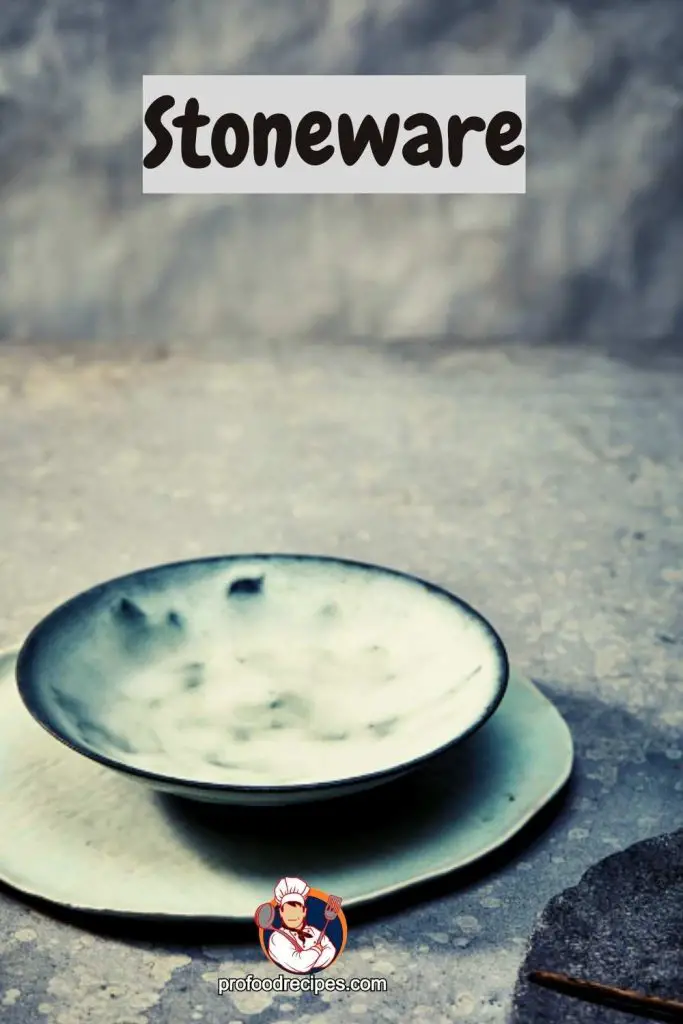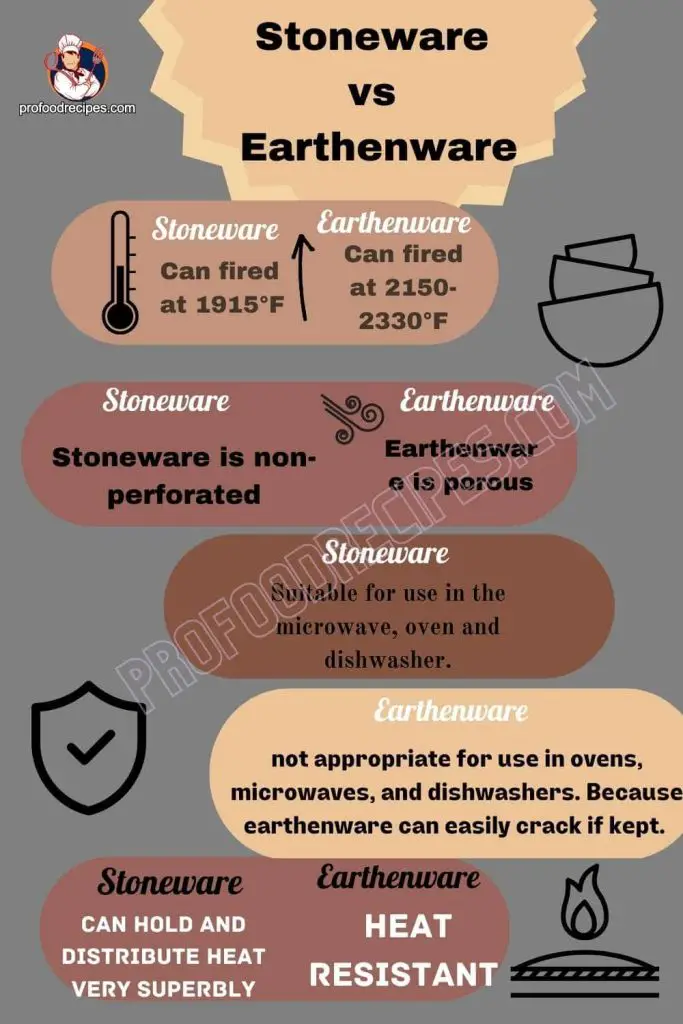Last Updated on February 16, 2023 by Amanda P. Brown
The major distinction between stoneware and earthenware is that stoneware is hard and non-porous, whereas earthenware is soft and porous. Also, stoneware is more long-lasting than earthenware, constructed from low-quality clay.
Earthenware and stoneware are both traditional potteries. They are compatible with any kitchen and most familiar wares. However, if you are baffled in choosing between earthenware and stoneware, which is best for you?
This article will help you determine the difference between earthenware and stoneware and their characteristics. Through this, you can easily choose the right clay pot. Let’s move to the below.
Difference Between Earthenware and Stoneware
Table of Contents
Generally, when discussing pottery, earthenware and stoneware remain the first-row pot types for learner potters.
Though earthenware and stoneware are equally common in every kitchen, the main purpose of holding food is the same for both wares. But they have some notable differences in material, durability, porosity, strength, and even price difference.
Moreover, different clays made these vessels different by the firing temperature.
However, let’s know first about their definition and their feature separately.
What is Stoneware?

Stoneware, a type of ceramic fired to temperatures between 2,150 and 2,330 degrees Fahrenheit, is known for its density and strength. The high temperatures and glassy material make it more sustainable. Due to its density, stone-like qualities, and appearance, everyone calls them stoneware. It is one kind of non-porous ceramic dinnerware made of clay.
This sustainable pot is available in many shapes. There are 5 basic categories of stoneware such as thermos shock-resistant stoneware, traditional stoneware, chemical stoneware, electrical stoneware, and fine stoneware.
However, stoneware holds and distributes heat very superbly. Because of its exceptional capacity to retain heat, it can go straight from the oven to the table, which is useful for keeping food warm.
Moreover, stoneware is ideal for daily use. This is because these dinnerware sets contain a wonderful finishing glaze, which gives the material a smooth appearance and a waterproof finish. Consequently, this makes stoneware suitable for daily use.
Features of Stoneware
Let’s see the features of stoneware at a glance.
- Earthy and rustic look.
- Excellent heat retention capacity
- Incredible durability and is ideal for regular use.
- Water-resistant and even doesn’t require glazing.
- Dishwasher, microwave, oven, and freezer-safe.
- Excellent for baking the whole thing from bread-pizza.
Read More: Different Types of Dinnerware and Their Uses with Picture
What is Earthenware?

Earthenware is a type of pottery made of coarse-grained clay, fired at 1915°F, much less than stoneware. These wares are usually porous. It is found abundantly in nature and has many uses. For example, Food containers, building bricks, pots, and roof tiles are made from this earthenware.
These pots are available in various designs and sizes. You can buy these pots from any store without thinking about the location and brand of these clay pots. Even you can get them at very affordable prices compared to other modern branded cookware.
However, this earthenware supports slow cooking and requires less oil for cooking than other cooking pots. Also, the earthy flavor of these earthenware dishes is good for your health as the food is made with less oil.
They greatly retain the original flavor and nutrients of the food. Also, these earthenware are great for cooking and are approved by health specialists. These earthenware are usually alkaline, which helps to neutralize the acidic tendency of food, digest food quickly, and maintains pH balance.
Also, foods cooked in earthenware are rich in magnesium, calcium, Sulphur, and phosphorous, which are some of the minerals that our body needs.
As earthenware is porous, they help distribute heat evenly throughout the dish and soften the food. With the slow-cooking mixture, this earthenware adds an earthy taste to the dish and maintains the food’s nutritional value, flavor, and goodness. Moreover, Foods prepared in this earthenware stay fresh for a very long time.
Features of Earthenware
Let’s see at a glance the features of earthenware.
- Low cost and easily available.
- Heat-resistant and porous pots
- Keep food tasting good and require a low amount of oil.
- Provide soft textured, nutrient-full, earthy-flavored food.
- Less durable, but careful handling can go it in the long run.
However, from the above information, you have learned the distinctive aspects. Now let us know about the comparative difference between earthenware and stoneware.
Difference Between Earthenware and Stoneware

| Earthenware | Stoneware |
| Low firing temperatures of up to 1915 degrees Fahrenheit are used. | It goes through a very hot firing (in the range of 2150°F to 3330°F). |
| Earthenware is porous | Stoneware does not have any cracks in it. It is non-perforated. |
| Earthenware is less strong than stoneware. | Stoneware is much stronger than earthenware. |
| Less durable than stoneware. | More sustainable than earthenware. |
| less expensive | Costly. |
| not great for everyday use | excellent for everyday use |
| Needs painting or glazing before use. | Does not require painting or glazing before use. |
| You can’t put earthenware in the microwave, oven, or dishwasher because it cracks too easily. Since pottery easily breaks if stored improperly. | Stoneware is suitable for use in the microwave, oven and dishwasher. |
| Earthenware is heat resistant. Because it is porous, it cannot retain heat efficiently. | Stoneware can hold and distribute heat very superbly. |
Earthenware and stoneware are appropriate from their respective places. However, from the comparative difference between earthenware and stoneware in the above table, you can choose either earthenware or stoneware at your convenience.
At a low budget, earthenware is a good option. But if you want a strong, durable pot and don’t have an issue with price, then stoneware is a better choice. (Though this durable, long-lasting pot will be worth the cost of its service over time.)
Read More: Carbon Steel Vs. Stainless Steel Pan
FAQs
How to Store Your Earthenware and Stoneware?
You can keep this stoneware away in common spaces without thinking about any loss.
On the other hand, to keep this earthenware, it is necessary to store them in a dry, cool place that is not too moist because the porous ceramic material of earthenware can develop mold over time if it is kept in a damp environment.
Can You Use Stoneware and Earthenware in the Oven?
No, you cannot use earthenware in the oven, freezer, microwave, or dishwasher. Because it can easily crack if it stays in them, so, avoid using earthenware in the oven. On the other hand, you may use stoneware in the freezer, oven, microwave, and dishwasher because it is structurally stronger.
Final Verdict
From the above article, you have known the difference between earthenware and stoneware, which will help you to choose the right pot between earthenware and stoneware.
However, if you’re looking for inexpensive and permeable pots, earthenware is a good option. Again, stoneware is a good alternative if you’d want a pot that won’t absorb odors or flavors.
You May Also Like to Read:
- Pros and Cons of Stainless Steel Cookware
- Types of Cutlery With Pictures
- What is Luncheon Plate?
- Different Types of Bowl Shapes and Their Uses
- What is a Chop Plate or Charger Plate?
